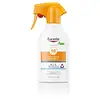What's inside
What's inside
 Key Ingredients
Key Ingredients

 Benefits
Benefits

 Concerns
Concerns

 Ingredients Side-by-side
Ingredients Side-by-side

Water
Skin ConditioningAlcohol Denat.
AntimicrobialButylene Glycol Dicaprylate/Dicaprate
EmollientButyl Methoxydibenzoylmethane
UV AbsorberBis-Ethylhexyloxyphenol Methoxyphenyl Triazine
Skin ConditioningEthylhexyl Triazone
UV AbsorberC12-15 Alkyl Benzoate
AntimicrobialCaprylic/Capric Triglyceride
MaskingDibutyl Adipate
EmollientDiisostearoyl Polyglyceryl-3 Dimer Dilinoleate
EmollientDiethylamino Hydroxybenzoyl Hexyl Benzoate
UV FilterPhenylbenzimidazole Sulfonic Acid
UV AbsorberCopernicia Cerifera Cera
EmollientHydrogenated Rapeseed Oil
EmollientGlycerin
HumectantGlycyrrhetinic Acid
Skin ConditioningGlycyrrhiza Inflata Root Extract
Skin ConditioningSucrose Polystearate
EmollientSodium Stearoyl Glutamate
CleansingHydrogenated Polyisobutene
EmollientXanthan Gum
EmulsifyingSodium Hydroxide
BufferingSodium Chloride
MaskingTrisodium EDTA
Caprylyl Glycol
EmollientHydroxyacetophenone
AntioxidantPhenoxyethanol
PreservativeWater, Alcohol Denat., Butylene Glycol Dicaprylate/Dicaprate, Butyl Methoxydibenzoylmethane, Bis-Ethylhexyloxyphenol Methoxyphenyl Triazine, Ethylhexyl Triazone, C12-15 Alkyl Benzoate, Caprylic/Capric Triglyceride, Dibutyl Adipate, Diisostearoyl Polyglyceryl-3 Dimer Dilinoleate, Diethylamino Hydroxybenzoyl Hexyl Benzoate, Phenylbenzimidazole Sulfonic Acid, Copernicia Cerifera Cera, Hydrogenated Rapeseed Oil, Glycerin, Glycyrrhetinic Acid, Glycyrrhiza Inflata Root Extract, Sucrose Polystearate, Sodium Stearoyl Glutamate, Hydrogenated Polyisobutene, Xanthan Gum, Sodium Hydroxide, Sodium Chloride, Trisodium EDTA, Caprylyl Glycol, Hydroxyacetophenone, Phenoxyethanol
Homosalate 5.5%
Skin ConditioningEthylhexyl Salicylate 4.5%
UV AbsorberOctocrylene 4%
UV AbsorberButyl Methoxydibenzoylmethane 2%
UV AbsorberC12-15 Alkyl Benzoate
AntimicrobialCetearyl Alcohol
EmollientPhenoxyethanol
PreservativeVp/Eicosene Copolymer
Diisopropyl Adipate
EmollientNeopentyl Glycol Diheptanoate
EmollientMica
Cosmetic ColorantDimethicone
EmollientGlycerin
HumectantParfum
MaskingPolymethylsilsesquioxane
Acrylates/C10-30 Alkyl Acrylate Crosspolymer
Emulsion StabilisingCoco-Glucoside
CleansingMethylparaben
PreservativePropylene Glycol Dibenzoate
Skin ConditioningCeteth-10 Phosphate
CleansingDicetyl Phosphate
EmulsifyingPropylparaben
PreservativeSodium Hydroxide
BufferingDisodium EDTA
Paraffin
PerfumingXanthan Gum
EmulsifyingButyrospermum Parkii Butter
Skin ConditioningJojoba Alcohol
EmollientPotassium Jojobate
Skin ConditioningSimmondsia Chinensis Butter
Skin ConditioningMangifera Indica Seed Butter
Skin ConditioningPropanediol
SolventTocopheryl Acetate
AntioxidantCarica Papaya Fruit Extract
Skin ConditioningColocasia Antiquorum Root Extract
Skin ConditioningMangifera Indica Fruit Extract
Skin ConditioningPassiflora Incarnata Fruit Extract
Skin ConditioningPlumeria Acutifolia Flower Extract
Skin ConditioningPsidium Guajava Fruit Extract
AstringentPanthenol
Skin ConditioningAloe Barbadensis Leaf Juice
Skin ConditioningSodium Ascorbyl Phosphate
AntioxidantTitanium Dioxide
Cosmetic ColorantHomosalate 5.5%, Ethylhexyl Salicylate 4.5%, Octocrylene 4%, Butyl Methoxydibenzoylmethane 2%, C12-15 Alkyl Benzoate, Cetearyl Alcohol, Phenoxyethanol, Vp/Eicosene Copolymer, Diisopropyl Adipate, Neopentyl Glycol Diheptanoate, Mica, Dimethicone, Glycerin, Parfum, Polymethylsilsesquioxane, Acrylates/C10-30 Alkyl Acrylate Crosspolymer, Coco-Glucoside, Methylparaben, Propylene Glycol Dibenzoate, Ceteth-10 Phosphate, Dicetyl Phosphate, Propylparaben, Sodium Hydroxide, Disodium EDTA, Paraffin, Xanthan Gum, Butyrospermum Parkii Butter, Jojoba Alcohol, Potassium Jojobate, Simmondsia Chinensis Butter, Mangifera Indica Seed Butter, Propanediol, Tocopheryl Acetate, Carica Papaya Fruit Extract, Colocasia Antiquorum Root Extract, Mangifera Indica Fruit Extract, Passiflora Incarnata Fruit Extract, Plumeria Acutifolia Flower Extract, Psidium Guajava Fruit Extract, Panthenol, Aloe Barbadensis Leaf Juice, Sodium Ascorbyl Phosphate, Titanium Dioxide
Ingredients Explained
These ingredients are found in both products.
Ingredients higher up in an ingredient list are typically present in a larger amount.
Also known as Avobenzone, this ingredient is a chemical sunscreen filter that provides protection in the UV-A range.
Avobenzone is globally approved and is the most commonly used UV-A filter in the world.
Studies have found that avobenzone becomes ineffective when exposed to UV light (it is not photostable; meaning that it breaks down in sunlight). Because of this, formulations that include avobenzone will usually contain stabilizers such as octocrylene.
However, some modern formulations (looking at you, EU!) are able to stabilize avobenzone by coating the molecules.
Avobenzone does not protect against the UV-B range, so it's important to check that the sunscreen you're using contains other UV filters that do!
The highest concentration of avobenzone permitted is 3% in the US, and 5% in the EU.
Learn more about Butyl MethoxydibenzoylmethaneC12-15 Alkyl Benzoate is made up of Benzoic Acid and long chain alcohols. It has a low molecular weight.
C12-15 Alkyl Benzoate is an emollient and texture enhancer. Due to its solubility, it is often used in sunscreens to help evenly distribute active ingredients.
As an emollient, C12-15 Alkyl Benzoate helps soften and hydrate your skin. Emollients create a film on your skin that traps moisture within.
This ingredient has been reported to cause eye irritation.
Learn more about C12-15 Alkyl BenzoateGlycerin is already naturally found in your skin. It helps moisturize and protect your skin.
A study from 2016 found glycerin to be more effective as a humectant than AHAs and hyaluronic acid.
As a humectant, it helps the skin stay hydrated by pulling moisture to your skin. The low molecular weight of glycerin allows it to pull moisture into the deeper layers of your skin.
Hydrated skin improves your skin barrier; Your skin barrier helps protect against irritants and bacteria.
Glycerin has also been found to have antimicrobial and antiviral properties. Due to these properties, glycerin is often used in wound and burn treatments.
In cosmetics, glycerin is usually derived from plants such as soybean or palm. However, it can also be sourced from animals, such as tallow or animal fat.
This ingredient is organic, colorless, odorless, and non-toxic.
Glycerin is the name for this ingredient in American English. British English uses Glycerol/Glycerine.
Learn more about GlycerinPhenoxyethanol is a preservative that has germicide, antimicrobial, and aromatic properties. Studies show that phenoxyethanol can prevent microbial growth. By itself, it has a scent that is similar to that of a rose.
It's often used in formulations along with Caprylyl Glycol to preserve the shelf life of products.
Sodium Hydroxide is also known as lye or caustic soda. It is used to adjust the pH of products; many ingredients require a specific pH to be effective.
In small amounts, sodium hydroxide is considered safe to use. However, large amounts may cause chemical burns due to its high alkaline.
Your skin has a natural pH and acid mantle. This acid mantle helps prevent harmful bacteria from breaking through. The acid mantle also helps keep your skin hydrated.
"Alkaline" refers to a high pH level. A low pH level would be considered acidic.
Learn more about Sodium HydroxideXanthan gum is used as a stabilizer and thickener within cosmetic products. It helps give products a sticky, thick feeling - preventing them from being too runny.
On the technical side of things, xanthan gum is a polysaccharide - a combination consisting of multiple sugar molecules bonded together.
Xanthan gum is a pretty common and great ingredient. It is a natural, non-toxic, non-irritating ingredient that is also commonly used in food products.
Learn more about Xanthan Gum